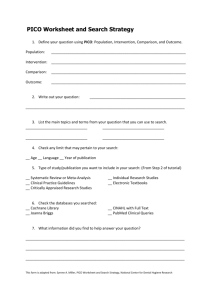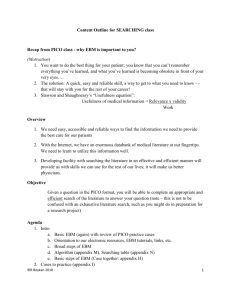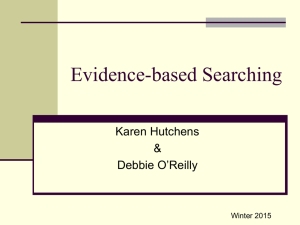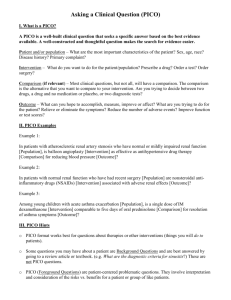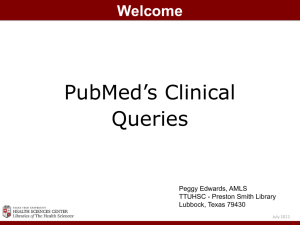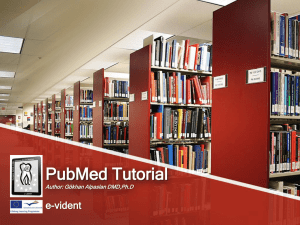PowerPoint - Texas Tech University Health Sciences Center
advertisement
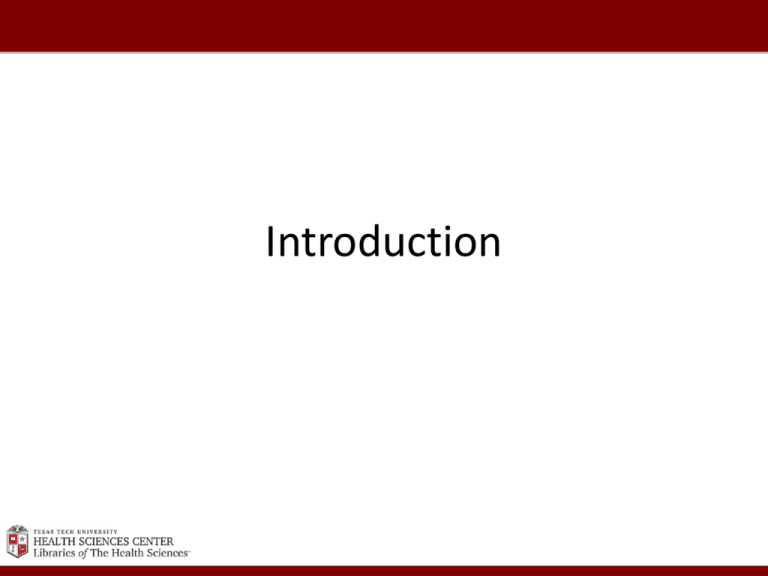
Introduction This workshop will: • Goal o Create Research OSCE at your institution • Objectives o Identify collaborative opportunities o Brainstorm necessary institutional resources How does this process work? Educational Goals • To assess a patient’s condition via examination and differential diagnosis • To ask a primary question about the case • To acquire information via exploration of the literature • To appraise information for level of evidence and relevance to the case • To apply information in order to establish treatment plan Objectives • Create a focused, well-articulated question using the PICO (patient, intervention, comparison, and outcome) model • Distinguish between the various point–of–care tools, the types of data retrieved from each tool, and incorporate their use into daily practice • Search PubMed effectively Objectives • During the OSCE (objective structured clinical exam), the participant will select various point–of–care tools and assess the data retrieved to determine the best answer to the test question • *Integrate the EBM (evidence–based medicine) process with clinical expertise and the patient's values *Glasziou, Paul. Centre for Evidence-Based Medicine, Downloads. Hp. July, 2003. Powerpoint: Introduction to EBM. University of Oxford and Queensland. Available: http://www.cebm.net/learning_ebm.asp. 10 Apr. 2005 The student will: • ASK a PICO patient clinical question o Receive instruction on EBM & PubMed databases o Practice PICO question with new knowledge • Acquire the information from each point–of–care database and compare • Appraise and compare information retrieved from point–of–care databases • Apply new skills and knowledge PICO What is it? How do you apply it? Define PICO PICO is an acronym that describes the elements of a well-formed clinical question. PICO: 1st determine the type of question • Clinical Question: o Therapy o Diagnosis o Harm o Prognosis PICO P= Patient • Patient, population or problem being addressed o What are the characteristics of the patient or population? o What is the condition or disease? PICO P= Patient I= Intervention • Intervention being considered which could include: o Exposure o Diagnostic test o Prognostic factor o Therapy o Patient perception PICO P= Patient I= Intervention • Intervention: o What do you want to do with/for the patient? • Medication option? • Surgical option? • No treatment? PICO • What is the alternative to the intervention? P= Patient I= Intervention C= Comparison of interventions or exposures o Medication option? o Surgical option? o No treatment? PICO P= Patient I= Intervention C= Comparison of interventions or exposures O= Outcome of interest • What are the relevant clinical outcomes of interest to your patient and you? o Full/partial recovery? • Remission o Complications? • Morbidity? • Death? Focused, well–built question • Once you fill out PICO form • Then you can formulate an answerable question ASK Student will identify a search question based on a patient case PICO • P= 35 yr old smoker 35 yr. old man with 2 pack/week smoking habit. Promised fiancé that he would quit smoking before their wedding next year. • I= medication Should medication and/or lifestyle changes be suggested? • C= lifestyle change • O= quit smoking ACQUIRE Using point–of–care databases, student will locate information to answer PICO question DATABASES Point–of–Care • • • • • ACP PIER DynaMed Essential Evidence Plus First Consult National Guideline Clearinghouse • PubMed Clinical Queries • MedlinePlus (Patient education database) © © © © © © © ACP PIER • Over 400 disease based modules • Covers Diseases, Procedures, Screening and Prevention, Complementary/ Alternative Medicine, Ethical and Legal issues • Includes level of evidence indicators DynaMed • Clinically-organized summaries for more than 3,000 topics • Monitors the content of over 500 medical journals and systematic evidence review databases by using many journal review services • Includes level of evidence indicators and updated daily Essential Evidence Plus (EE+) • Online repository of content from 2,500 journals, books, reference works, databases, laboratory manuals and The Cochrane Library • Decision support calculators and clinical tools • Includes level of evidence indicators First Consult • Evidence–based portion of MD Consult • Information is based on multiple sources, reviewed and edited by opinion leaders in clinical practice • Includes medical topics, procedures and differential diagnoses National Guideline Clearinghouse • Public resource provided by the federal government • Evidence–based clinical practice guidelines • www.guideline.gov PubMed Clinical Queries • Public resource provided by the federal government • Provides access to specialized PubMed searches designed to quickly connect clinicians with evidence-based clinical literature • Has five study categories – Etiology, Diagnosis, Prognosis, Clinical Prediction Guidelines and Therapy • www.ncbi.nlm.nih.gov/pubmed/ clinical MedlinePlus • Public resource provided by the federal government • National Institutes of Health's website for patient education • Joint project with National Library of Medicine • About diseases, conditions, and wellness issues in language that the general public can understand • www.medlineplus.gov DATABASES • PubMed Specialized • Gold Rush PubMed • Public resource provided by the federal government • Comprises approximately 20 million citations for biomedical literature from MEDLINE, life science journals, and online books • Includes medicine, nursing, dentistry, veterinary medicine, health care systems, preclinical sciences, NCBI molecular biology and genetic resources • www.pubmed.gov Gold Rush • Most complete listing of our TTUHSC print and online journals • Includes almost 20,000 print and online journals • View TTUHSC purchased articles with password and ID Foundations of searching PubMed (Hands-on) MeSH Boolean Logic (AND OR) Subheadings Explode feature Checklist info MeSH vs. Major topic Limits and Advanced Search Publication Types, MeSH Terms, Substances, Grant Support Foundations of searching PubMed (Hands-on) Checklist info continued Abstract format Clipboard E-mail Full-text icons Type of Article; Subsets: Systematic Reviews My NCBI (set up Search Filters) Export (Brief Intro to RefWorks) In smokers what medication and/or life style changes are effective to stop smoking? ACP PIER, DynaMed, EE+, First Consult, NGC, Medlineplus, PubMed Clinical Queries, PubMed Medication (MeSH) = Pharmaceutical Preparations Lifestyle changes (MeSH) = life change events Stop smoking (MeSH) = Smoking cessation ACP PIER DynaMed Essential Evidence Plus (EE+) First Consult National Guideline Clearinghouse (NGC) MedlinePlus (Patient Education) PubMed Clinical Queries PubMed "Pharmaceutical Preparations” [Mesh] OR "Life Change Events"[Mesh] AND "Smoking Cessation”[Majr] AND "humans"[MeSH Terms] AND English[lang] APPRAISE Student will review data and explain relevance to librarian – during one–on–one session and OSCE APPLY Student will present how the information is applicable to case DEBRIEFING Student will review with physician http://www.ttuhsc.edu/libraries http://www.ttuhsc.edu/libraries Small group discussions Where are you at the moment: Small group discussions Goal/Idea: Small group discussions Persons to contact: Small group discussions Persons/Departments to contact: Small group discussions Resources needed: Small group discussions Facilities/Locations: Small group discussions Time: Small group discussions How to evaluate performance: Small group discussions How to assess class: ??? Contact Information Andrew Neal Dentino, M.D. Texas Tech University Health Sciences Center School of Medicine – Lubbock Department of Internal Medicine 3601 4th St Stop 9410 Lubbock, TX 79430-9410 andrew.dentino@ttuhsc.edu 806-743-3155 x221 Stephanie Shippey, MLS, AHIP Dawn Kruse, MSIS Margaret Vugrin, MSLS, AHIP Texas Tech University Health Sciences Center Preston Smith Library of the Health Sciences – Lubbock 806–743-2208 mylibrary@ttuhsc.edu Thank you!
